Néstor Cortes Jr.’s fastball isn’t supposed to be this good. He’s thrown 387 of them this season, at an average velocity of 90.5 MPH and 2198 RPM. Those are the highest velocities of his career, as he averaged 88.2 MPH in 2020 and 89.6 MPH in 2019. 2200 RPM on a high-eighties/low-nineties fastball makes for an above-average spin/velocity ratio, but it’s nothing special—and nothing that should be holding hitters to a measly .165 batting average against, one of the very best in the league among anyone who’s thrown as many as he has.
Jacob deGrom, and then Néstor Cortes Jr.. Excuse me? Can that be right? It is batting average, of course, so it doesn’t mean that much. Holding hitters to a low average is great, but when you work with a velocity that low, a lot of the hits you do give up are probably big ones.
Great, we have stats to account for that. But the leaderboards for wOBA and xwOBA look pretty dang similar to the one for batting average.
Most of my deep dives start with a “one of these things is not like the other” on some leaderboard or other, and this is no exception. Seriously, what is Cortes doing with all those power arms and filth merchants?
The other fastballs on those lists that don’t have elite velocity have other unorthodox traits. Bassitt and Lynn’s primary offerings play similarly in that they throw hitters off via a well-tunneled mix of four-seamers, sinkers, and cutters. Sewald’s spin is through the roof; McGee comes with some funky arm action, and Freddy Peralta has one of the flattest vertical approach angles in the game.
So before we dive into Cortes’s fastball, let’s take a look at the big picture. In case the ear-shattering loudness of Yankees fandom since the trade deadline hasn’t been clear enough, Cortes is having a really good season. Making seven appearances out of the bullpen before sneaking into the rotation for seven starts, he’s run a 2.56 ERA over 56.1 innings, with a 3.39 FIP, 4.17 xFIP, and 3.80 SIERA to back it up. He’s struck out 60 over those 56 innings, walking just 15 in the process.
Despite horrendous results last season and an ugly ERA in 2019, Cortes dropped hints of something potentially valuable in that latter year, posting an almost perfectly league-average 24% strikeout rate and 9% walk rate that would seem to play above his stuff, but still tracked relatively well with his minor league production. The problem is that when the ball was put in play, it led to disaster. He allowed a .427 wOBA on contact and .494 slugging, and it was well-earned: a .393 expected wOBA on contact was one of the league’s worst, and relatively unremarkable peripherals like a .321 BABIP and 18% HR/FB indicate there wasn’t much luck involved. That the Yankees chose to non-tender him after that season was a shock to nobody.
This year, of course, the tides have completely changed, and seemingly out of nowhere, given his utter ineffectiveness in six appearances with Seattle last season. His walk and strikeout rates are still nothing special, but a small yet tangible improvement to both of those has been enough to place him in a tier of pitcher that he wouldn’t have belonged in before this season. His 19.6% K-BB rate is in the 76th percentile of starters with at least 50 innings pitched, a ranking that seems to be almost universally associated with solidly average to above-average run prevention.
At the same time that his walk and strikeout rates moved from those of a fringe starter to a legit mid-rotation piece, his contact suppression took off in a good way. That .393 expected wOBA on contact that he allowed in 2019 has moved all the way down to .305, which ranks in the top-6% of the league this season. How does that happen? Baseball Savant’s swing/take charts show us how getting outs on swings where he was previously getting hurt has been critical to his success.
Starting on the left, we see where the biggest improvements are coming from. In the heart and shadow zones, he went from a measly five runs below expected to a total of 22 below, but with about 400 fewer pitches in the bank. That’s a lot! As one would expect from the expected stats quoted earlier, hitters clearly aren’t doing anything with pitches over or adjacent to the plate. Moving to the charts on the far right, we can also see that the improvement is entirely coming from swings. Take runs in those zones are exactly where they were before. And even though his strikeouts are up, those extra runs prevented aren’t coming from increased whiffs—his whiff and swinging strike rates are actually down from 2019. These extra outs are coming on balls in play.
About that. One would be valid in pointing out that his abnormally low .268 BABIP and 9.2% HR/FB are likely to bounce the other way sometime soon. That’s probably true. But at the same time, that .306 expected wOBA on contact doesn’t lie, and interestingly, Statcast thinks he’s actually gotten a touch unlucky when it comes to homers, giving up 6 HR to 4.8 xHR. Still, it should go without saying that he’s having some breaks go his way. He’s almost certainly not a true 2.50 ERA talent, just like his fastball probably isn’t going to be one of the most effective in the majors over a full season.
That doesn’t mean there’s nothing real or significant in this nice run of his. If Cortes turns out to be a legit back-end rotation member, that’s as good of a success story as you can come up with for a 36th round draft pick. So I’m not going to dig for a way to tell you why his fastball is playing as well as it is, because beyond the shock value of a leaderboard, there’s nothing really special about it. It’s got solid ride for its velocity, with a bit of above-average vertical movement and not a lot of horizontal movement. It’s got a .210 wOBA and expected wOBA because he’s gotten a bit lucky, but also because he’s been maximizing his arsenal by doing some unorthodox things that most pitchers can’t (or don’t) do.
As a hitter, I imagine it’s pretty hard to know what to do with that! Of course, he doesn’t go to those extremes very much. But the spirit is constantly there. He rarely does the same thing twice in a row, in direct opposition to a game entirely predicated on routine. Things probably get a little weird when you’re two pitches into an at-bat and the pitcher suddenly starts doing this:
Look at how Nimmo’s hands and front leg stutter multiple times—he has no idea when to start his load! This pitch might have missed for a ball, but it doesn’t seem like Nimmo was ready to put a good swing on it no matter where it went. So anyway, you’re Brandon Nimmo, and you’ve already got that weirdness to keep an eye on. Then, Cortes follows it up a few pitches later with this:
It’s not extreme messing with timing like that first example, but it’s still not quite Cortes’s business as usual. Seeing all those different things back-to-back is at least part of how a hitter can wind up completely unprepared for an unremarkable fastball at the knees.
Timing isn’t the only element of trickery, either. If you were paying attention, you’ll notice that all three of those pitches came from slightly different arm slots.
Nestor Cortes, Arm Slots/Mechanics. pic.twitter.com/H7IZnikJaJ
— Rob Friedman (@PitchingNinja) August 21, 2021
Conventional wisdom says that a pitcher wants as little variation in their release point as possible, both because it begets more consistent, repeatable mechanics—and therefore better control/command—and also because it aids tunneling, making it difficult for the hitter to figure out which pitch is what until it’s far too late. Marcus Stroman is a prime example. Like Cortes, he compensates for subpar velocity with timing tricks and a wide arsenal, making six or seven different pitches come out of virtually the same spot.
Cortes, meanwhile, looks at your conventional wisdom and says boo hoo ha ha. Néstor Cortes Jr. throws the ball from whatever arm slot he feels like using when he wakes up, things like “repeatability” and “tunneling” be damned.
The only problem is that this isn’t new. Cortes was doing plenty of timing tricks back in 2019, and his release point chart from that year was just as varied, perhaps even a touch more so.
The difference this year is location. The thing about changing a release point that much is that when you aren’t ever doing the same thing twice in a row, it makes it incredibly hard to consistently throw the ball exactly where you want it. Cortes, however, has been excellent at pounding the same location with all of his pitches despite never quite throwing them from the same place. His slider, for example, is a show-me pitch against lefties, but a weapon against opposite-handed hitters. With lefties, he gets it over the plate, and with righties, he dots it in the same spot on their hands almost every time. Note that FanGraphs’ heat maps use data that label his slider as a cutter and his curveball as a slider.
 |
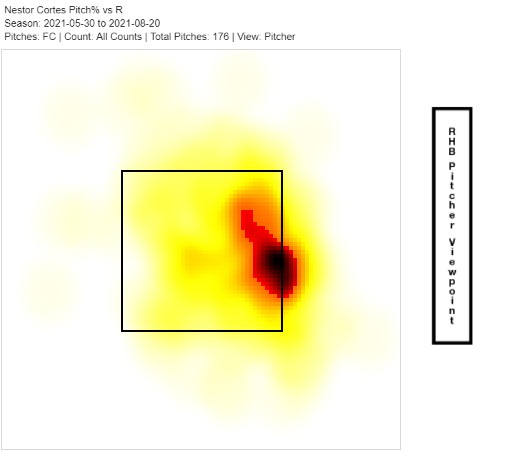 |
That’s great, but hitters have actually torn up his slider for a .402 wOBA and .341 xwOBA this season. So what? Well, he can do the exact same thing with his curveball, a pitch that’s gotten excellent expected results (.241 xwOBA) and an above-average 33% CSW. He can use that pitch against hitters on either side, dropping it perfectly in the backdoor against righties and making it dive away from lefties into the opposite corner at the knees.
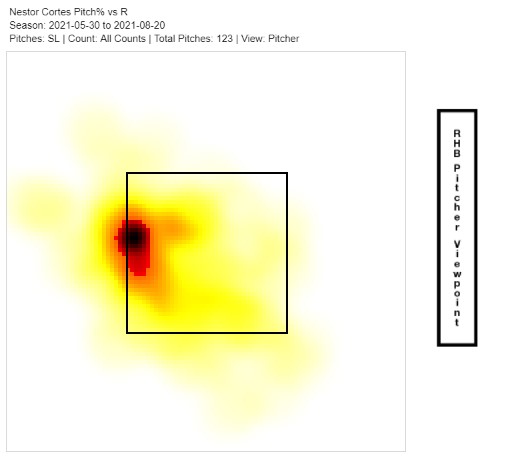 |
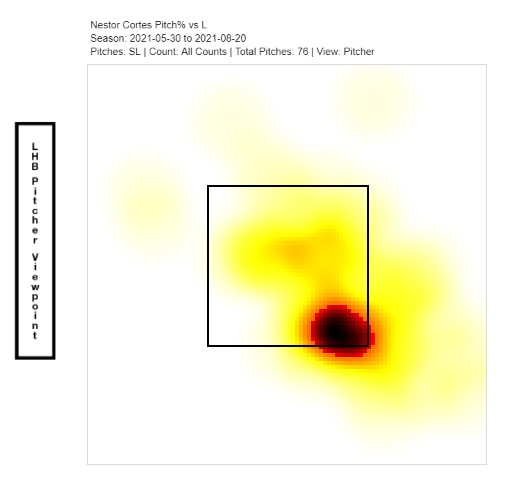 |
Finally, there’s his changeup, which he’s thrown exclusively to right-handers this year.
Again, a great traditional location for a pitch that’s designed to “pull the string.” Overall, that’s a lot of consistency in location for someone who’s consistent in pretty much nothing else. He’s living in those tough-to-hit spots while keeping the hitter guessing in pretty much every possible way, and the effect is to make the most out of mediocre velocity and movement.
That guessing includes pitch selection, too. While much has remained the same, one of the most notable differences between Cortes now and his pre-pandemic iteration is that he’s become much less predictable in his pitch selection. While he threw the fastball and slider more than three-quarters of the time in his first go-around with the Yankees, he’s now splitting his breaking balls perfectly evenly between the curve and slider while maintaining his changeup usage against righties.
Just as with pitch locations, the changes to Cortes’s approach and selection are even starker when you split them up by batter handedness. Against same-handed hitters, Cortes has almost completely abandoned the slider, opting to attack them with the high-fastball, low-curveball combination.
Meanwhile, the development of that curveball has allowed him to mix up his pitches even more against right-handers, giving hitters four viable pitches that they have to think about coming out of the hand.
The last thing I’ll leave you with is the aforementioned development of that curve because it might just be the key to the process that seems to have transformed Cortes from an unremarkable quad-A swingman to a potentially effective spot-starter/multi-inning reliever for a playoff-quality team. Cortes has always thrown a curveball—it was his primary breaking pitch in his first partial season in the big leagues—but until this year, it was basically a slow version of his slider; the pitches had the same amount of side-to-side movement and similar spin characteristics, with the different vertical movement being mostly a function of velocity.
This year, his curveball is different. Its spin direction has shifted from 4:00 on a clock face to 2:45, meaning the pitch will have a lot more side-to-side movement than it did in the past. Lo and behold, the curveball in 2021 looks like a much, much more distinct pitch than it did in the past. It’s averaging more than 14 inches of horizontal movement and 41 inches of drop after those numbers sat at six and 51 inches the last time he played for the Yankees. It’s hard to tell from common TV camera angles, but it’s a totally different pitch!
Voilà! Piece it all together, and you’ve got just enough to convince me that whatever we’re seeing from Néstor Cortes Jr. right now isn’t quite a fluke, even if it’s not quite real, either. Baseball wouldn’t be baseball without a soft-tossing lefty fooling hitters with timing tricks as old as the game itself. Now, though, Cortes isn’t quite as soft-tossing as he used to be, and his bag of tricks actually belies some seriously impressive command. Whatever the Yankees saw in Cortes to bring him back after the disaster that was last season, it’s already paid more than its share of dividends for the as-yet unterminated roller coaster that has been their season.
A 2.56 ERA is a tough ask of all but the best of pitchers. Even if that’s not Cortes, he’s shown enough to stake a claim to a proper spot on a major league roster. For a 36th round pick and multi-time preseason afterthought, it’s hard to ask for a better success story.




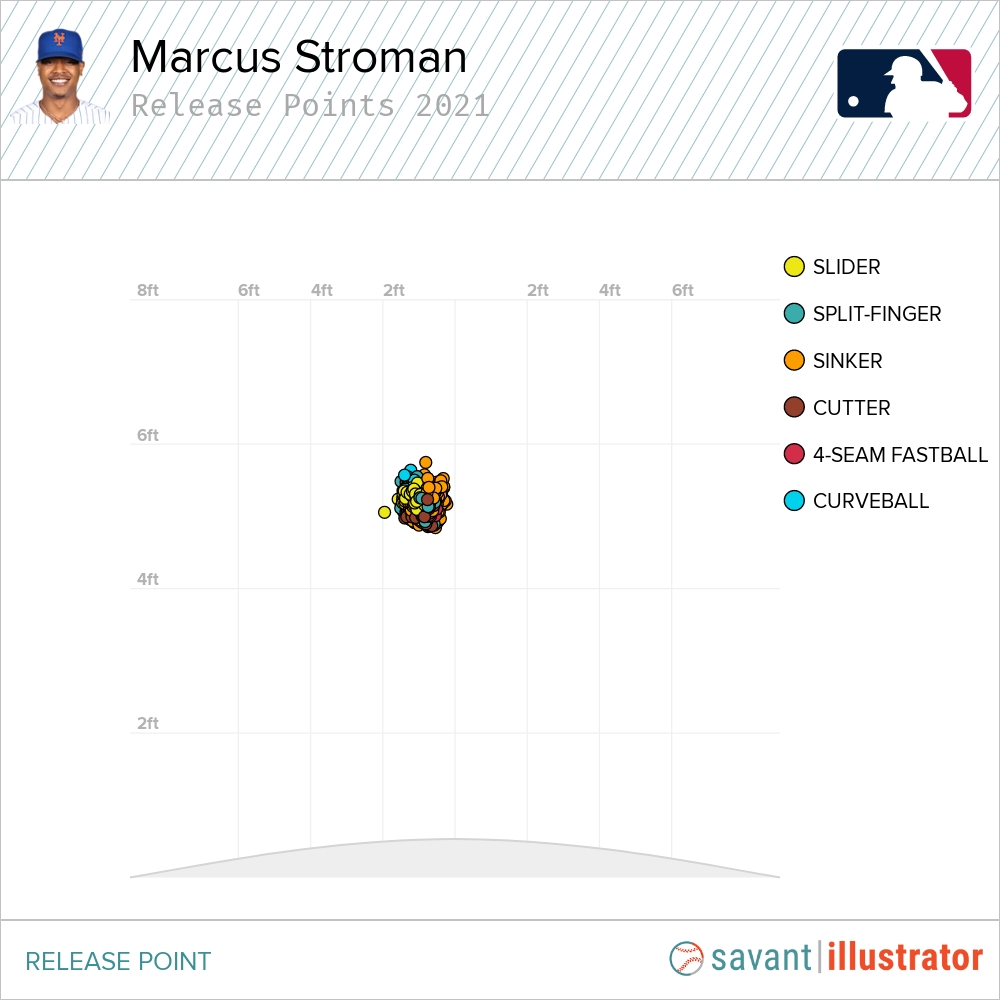
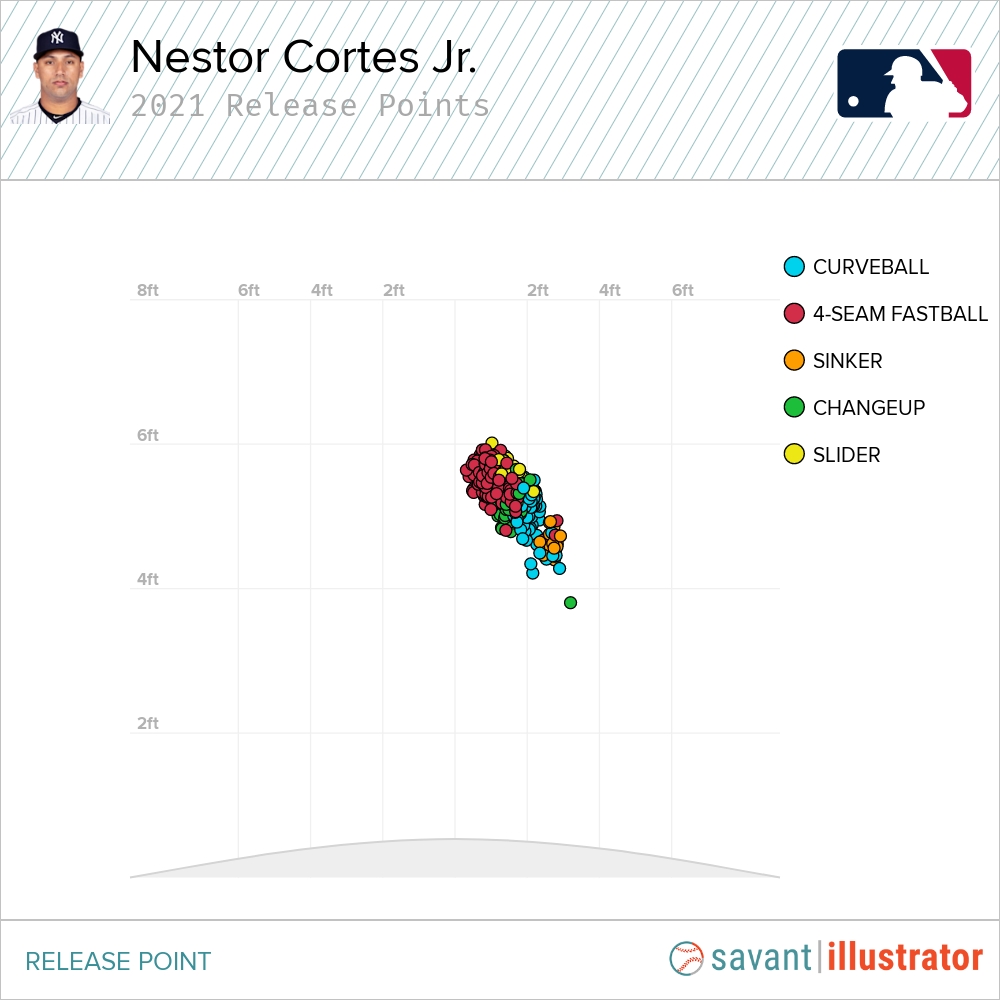
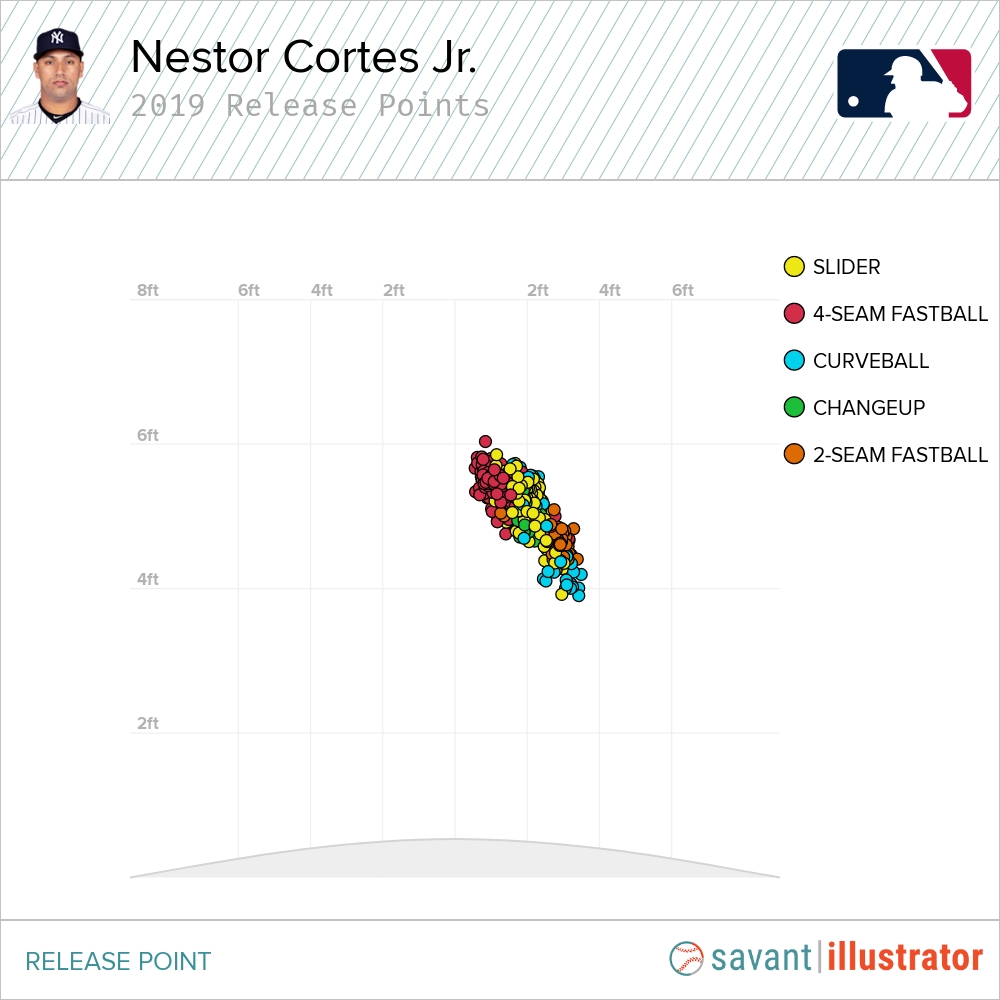
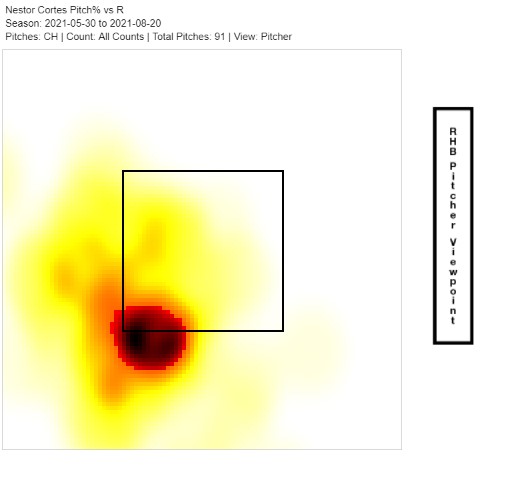
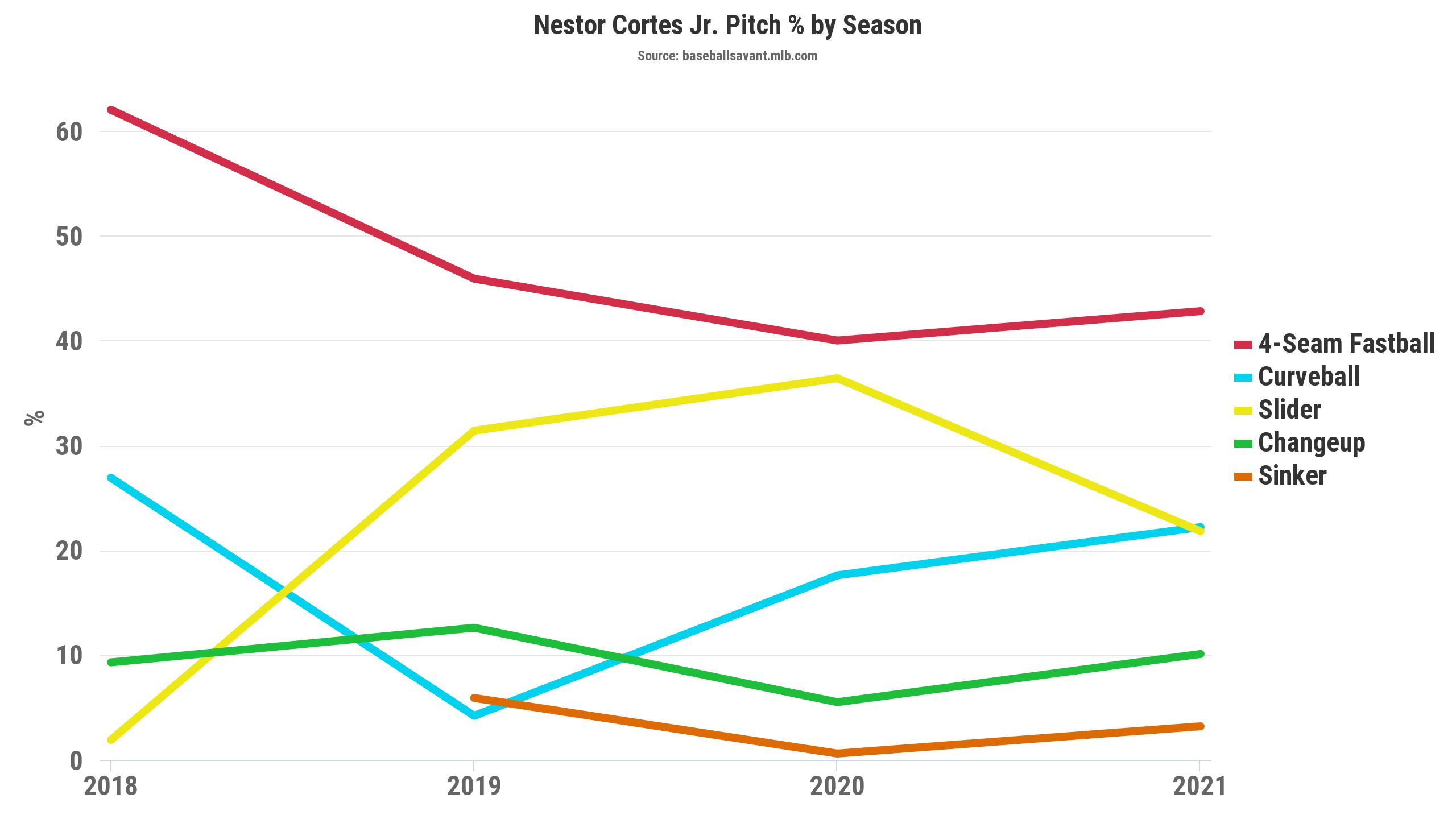
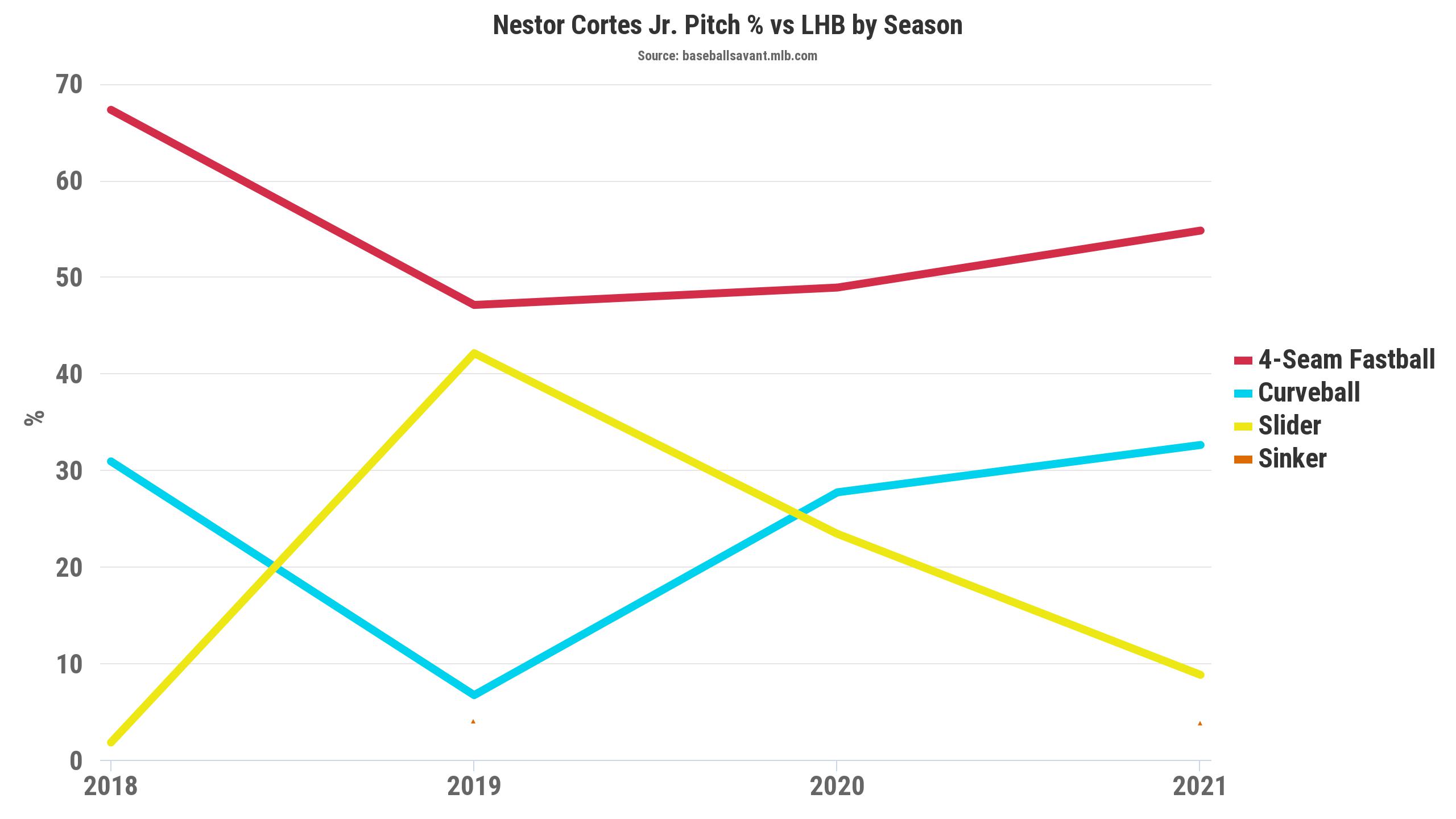
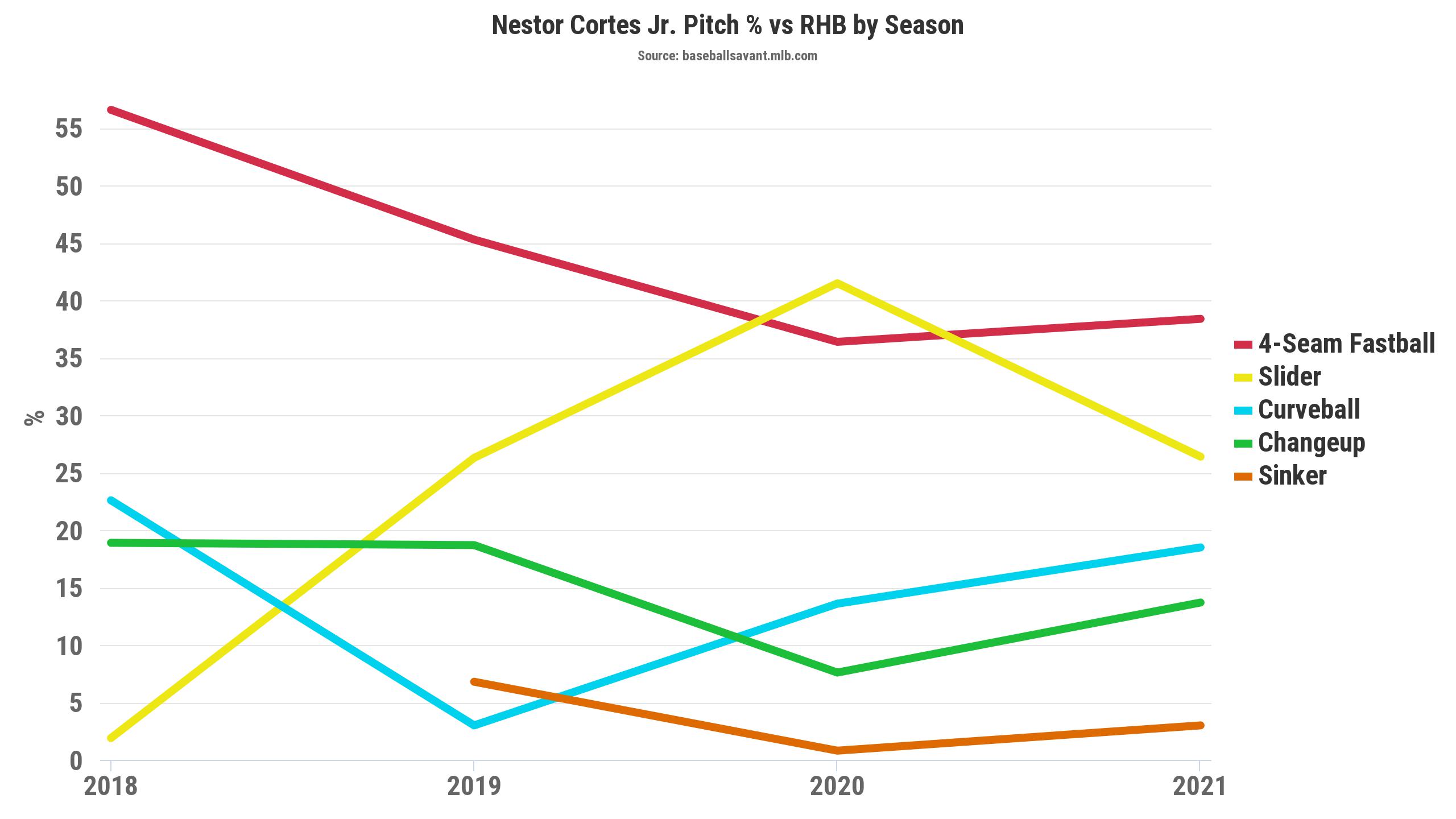
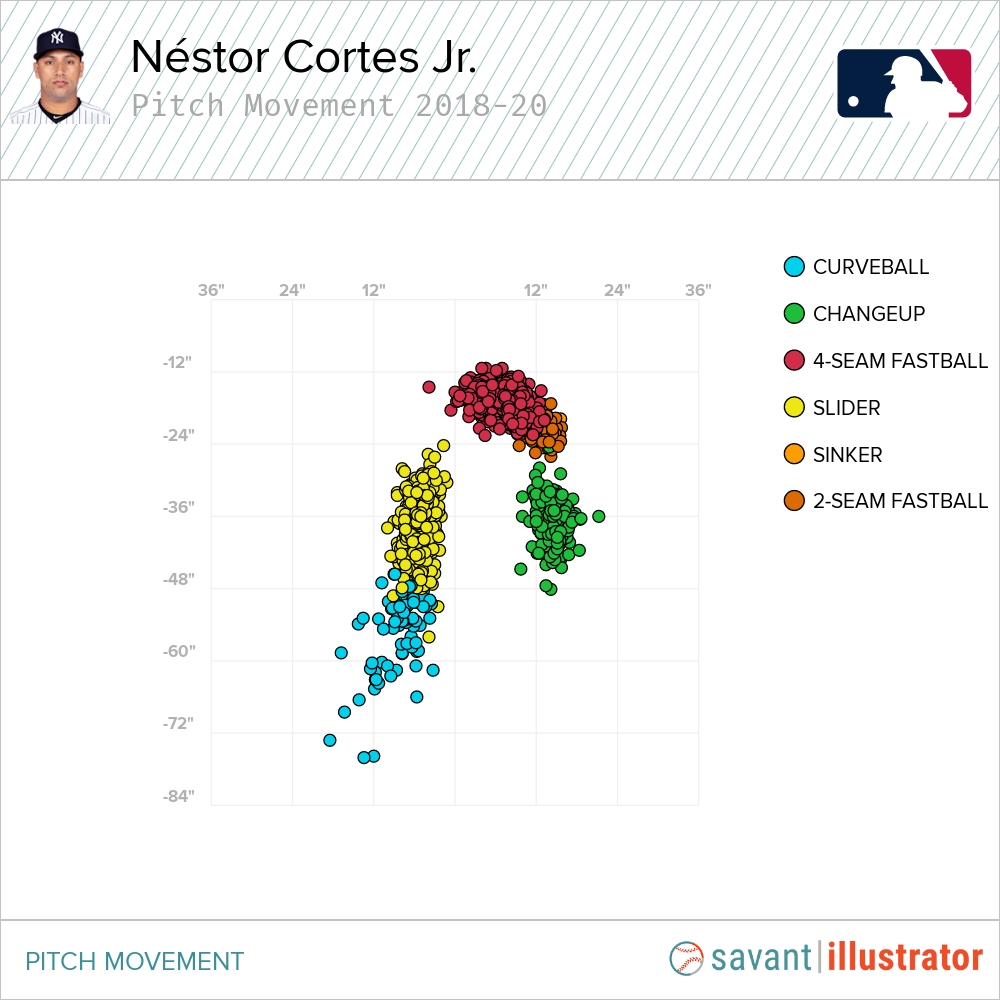
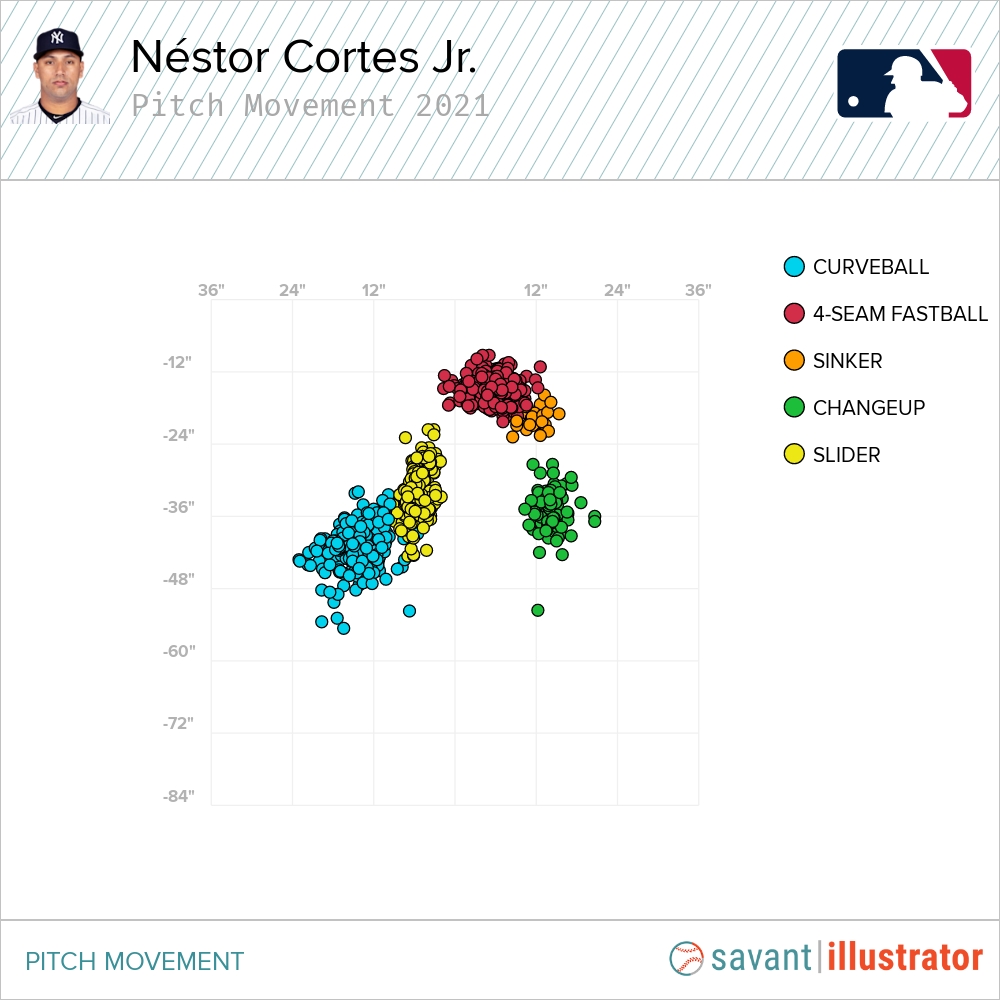
Cool. This article needed to be written, if only for posterity’s sake!!!